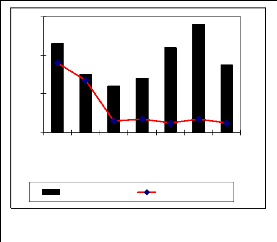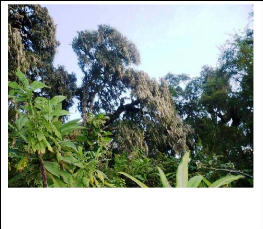4. DISCUSSION
4.1. Floristic richness and variation between different
phytocenoses
Results of this study show evidence of floristic richness in
the Mwaro corridor, which connect two afromountain phytocenoses (Nyamulagira
and Mikeno sectors). We noticed a good representation of the afromountain
species that have been recorded by Dowselt (1990) in Nyungwe forest: Olea
hochstetteri, Maesa lanceolata, Ilex mitis and Nuxia
congesta.
During our investigations, we identified Dombeya
goetzenii, endemic species of the eastern part of the Rift Albertine
region, in one of the Mwaro habitats. The Mwaro corridor is therefore an
important phytocenose were key important plant species are growing.
We compared our results with those obtained by other researchers
who undertook similar studies in other ecosystems, using the transect
method.
The study of plant diversity in the Mwaro ecological corridor
shows a decrease of a species richness of woody plants with increase in
altitude. Indeed, segments 1 and 2 located in the lower altitudes are the
richest. These 2

Figure 26. Distribution of woody and herbacous species in
different segments.
Number of species
40
60
50
30
20
10
0
Segl
ot Herbaceous
herbacées species Woody Espèces
species ligne
Seg2
Seg3
Seg4
Seg5
Seg6
Segments
Type se
Seg7
segments are in the altitudinal edge below 2000 m.
Thirty-six wood species are noted in segment 1 and 31 in
segment 2, while fewer than 10 species were found in segments located in higher
altitude (segments 3, 4, 5, 6, and 7).
One species economically coveted by local communities for
charcoal, Olea hochstetteri, forms an intact vegetal group in the
first two segments. It is one of the bigest trees growing in mountain forests,
also described by Dowselt (1990) in the Nyungwe forest.
Unlike the woody flora, qualitative study of the altitudinal
distribution of herbaceous species has in contrast showed little change in its
composition. The specific herbaceous composition of each segment depends on the
altitude, though the trend is not as such strongly remarkable as for woody
species as shown in Figure 26.
We indeed observe a decrease in the number of woody species from
the segment 3 and this number remains low towards the end of the line transect
(Figure 26).
In contrast, the number of herbaceous species decreased
slightly in segment 3, but the maximum is observed at high altitudes (see
segment 6). We therefore conclude that in the Mwaro corridor, the higher
elevations are richer in herbaceous species where woody species are rare.
Biodiversity survey of Mwaro corridor, Altitudinal
distribution of the vegetation and assessment of Gorilla food
availability

Page 43
4.2. Altitudinal variations along the line
transect.

Figure 27. Vegetation with Prunus Africana on Mikeno slope at
3200 m of altitude
The study of altitudinal variations in vegetation along the
line transect open in the Mwaro corridor has documented 3 different horizons
that match those described by Lebrun and Gillbert (1944) in mountain forests.
The first is the lower horizon located between 1600 and 1900 m, then the
average horizon between 1900 and 2100 m, and the higher horizon between 2100
and 2400 m above sea level. Species characteristic to these horizons are those
also suggested by these authors. It is for the case of the Mwaro survey the
following species: Bersama abyssinica ssp. paullinioides, Alangium
chinense, Lepidotrichilia volkensi, Olea hochstetteri and Xymalos
monosporous. Gillbert and Lebrun (1944) describe the following synecologic
features for this type of vegetation: heavy rainfall, low temperatures with
frequent fog, high radiation and high atmospheric humidity. The grounds are
covered with abundant litter with good composition and deep penetration of
humus. According to these authors, such vegetation presents the following
physiognomy and structure: species of medium size (20 to 25 m), a less dense
layer due to the lower density of the upper layer and greater intensity. Thus,
using these features we may classify the vegetation of the Mwaro corridor,
located between 1800 and 2400 m above sea level, in the phytosociological order
of FicalhoetoPodocarpetalia.
The study also highlighted the existence of a secondary forest
with Neoboutonia macrocalyx and Dombeya Goetzeni from 2400 m
and a development of Afro-montane vegetation from 2600 m of altitude. The
latter is dominated by species associated with Hagenia abyssinica
and Hypericum revolutum up to the upper limit at about 3000
meters of altitude. At this level, precipitation decreases significantly and
the average temperature drops rapidly (Languy and Merode, 2006).
The transect open in Mwaro corridor and throughout the contour
line of 3000 m above sea level helped to discover another type of vegetation
that is still poorly known; it is a vegetation dominated by the Prunus
africana rich in Lobelia giberoa, Stachys aculeolata and
Crassocephalum lucis-aprutii in the herbaceous layer. At higher altitudes,
which our line transect didn't reach, Languy and De Merode (2006) noted the
presence of a forest heath, consisting mainly of the species of Philippia
johnstonii up to 10 m high and Erica arborea on the drier
slopes.
At the upper limit of tree heath (Afro-Alpine floor),
according to the same authors, there are large clearings towards 3700 meters
above sea level. Plant species most typical of these elevations are Lobelia and
Senecio, reaching about 8 m high.
Biodiversity survey of Mwaro corridor, Altitudinal
distribution of the vegetation and assessment of Gorilla food
availability
| 

